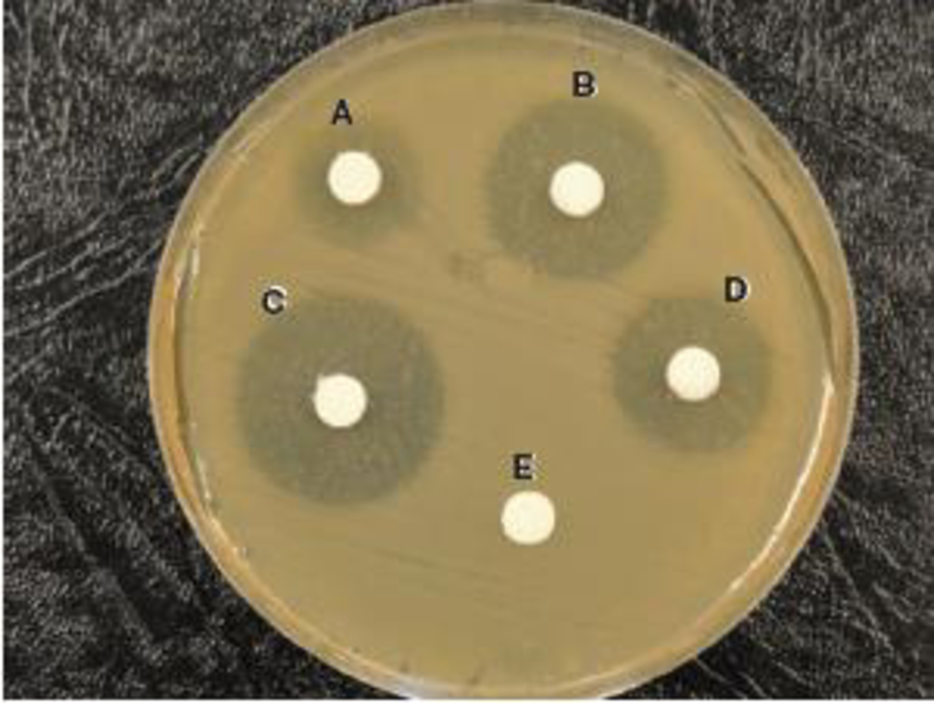
Prescott's Microbiology
11th Edition
ISBN: 9781260211887
Author: WILLEY, Sandman, Wood
Publisher: McGraw Hill
expand_more
expand_more
format_list_bulleted
Textbook Question
Chapter 9.3, Problem 1MI
To which antibiotic (A, B, C, D, or E) is the plated bacterium resistant?

Expert Solution & Answer
Want to see the full answer?
Check out a sample textbook solution
Students have asked these similar questions
Give only the mode of inheritance consistent with all three pedigrees and only two reasons that support this, nothing more, (it shouldn't take too long)
O
Describe the principle of homeostasis.
Chapter 9 Solutions
Prescott's Microbiology
Ch. 9.1 - Prob. 1CCCh. 9.1 - Louis Pasteur is often credited with saying,...Ch. 9.2 - Prob. 1CCCh. 9.2 - Prob. 2CCCh. 9.2 - Prob. 3CCCh. 9.3 - To which antibiotic (A, B, C, D, or E) is the...Ch. 9.3 - Prob. 1CCCh. 9.3 - Prob. 2CCCh. 9.3 - Prob. 3CCCh. 9.4 - MICRO INQUIRY What is the difference between...
Ch. 9.4 - Prob. 2MICh. 9.4 - Prob. 3MICh. 9.4 - MICRO INQUIRY How is the mechanism by which...Ch. 9.4 - Prob. 5MICh. 9.4 - Prob. 1CCCh. 9.4 - Prob. 2CCCh. 9.4 - Prob. 3CCCh. 9.4 - Retrieve, Infer, Apply What are antimetabolites?...Ch. 9.5 - Prob. 1CCCh. 9.5 - Prob. 3CCCh. 9.5 - Prob. 4CCCh. 9.6 - Prob. 1CCCh. 9.6 - Prob. 2CCCh. 9.6 - Prob. 3CCCh. 9.7 - MICRO INQUIRY What is the mechanism by which...Ch. 9.7 - Prob. 1CCCh. 9.7 - Retrieve, Infer, Apply Why is malaria, like...Ch. 9.7 - Prob. 3CCCh. 9.8 - Prob. 1CCCh. 9.8 - Prob. 2CCCh. 9.8 - Prob. 3CCCh. 9.8 - Prob. 4CCCh. 9 - Prob. 1RCCh. 9 - Prob. 2RCCh. 9 - Prob. 1ALCh. 9 - Prob. 2ALCh. 9 - Prob. 3ALCh. 9 - Prob. 4ALCh. 9 - Prob. 5AL
Knowledge Booster
Learn more about
Need a deep-dive on the concept behind this application? Look no further. Learn more about this topic, biology and related others by exploring similar questions and additional content below.Similar questions
- Explain how the hormones of the glands listed below travel around the body to target organs and tissues : Pituitary gland Hypothalamus Thyroid Parathyroid Adrenal Pineal Pancreas(islets of langerhans) Gonads (testes and ovaries) Placentaarrow_forwardWhat are the functions of the hormones produced in the glands listed below: Pituitary gland Hypothalamus Thyroid Parathyroid Adrenal Pineal Pancreas(islets of langerhans) Gonads (testes and ovaries) Placentaarrow_forwardDescribe the hormones produced in the glands listed below: Pituitary gland Hypothalamus Thyroid Parathyroid Adrenal Pineal Pancreas(islets of langerhans) Gonads (testes and ovaries) Placentaarrow_forward
- Please help me calculate drug dosage from the following information: Patient weight: 35 pounds, so 15.9 kilograms (got this by dividing 35 pounds by 2.2 kilograms) Drug dose: 0.05mg/kg Drug concentration: 2mg/mLarrow_forwardA 25-year-old woman presents to the emergency department with a 2-day history of fever, chills, severe headache, and confusion. She recently returned from a trip to sub-Saharan Africa, where she did not take malaria prophylaxis. On examination, she is febrile (39.8°C/103.6°F) and hypotensive. Laboratory studies reveal hemoglobin of 8.0 g/dL, platelet count of 50,000/μL, and evidence of hemoglobinuria. A peripheral blood smear shows ring forms and banana-shaped gametocytes. Which of the following Plasmodium species is most likely responsible for her severe symptoms? A. Plasmodium vivax B. Plasmodium ovale C. Plasmodium malariae D. Plasmodium falciparumarrow_forwardStandard Concentration (caffeine) mg/L Absorbance Reading 10 0.322 20 0.697 40 1.535 60 2.520 80 3.100arrow_forward
- please draw in the answers, thank youarrow_forwarda. On this first grid, assume that the DNA and RNA templates are read left to right. DNA DNA mRNA codon tRNA anticodon polypeptide _strand strand C с A T G A U G C A TRP b. Now do this AGAIN assuming that the DNA and RNA templates are read right to left. DNA DNA strand strand C mRNA codon tRNA anticodon polypeptide 0 A T G A U G с A TRParrow_forwardplease answer all question below with the following answer choice, thank you!arrow_forward
arrow_back_ios
SEE MORE QUESTIONS
arrow_forward_ios
Recommended textbooks for you
- Surgical Tech For Surgical Tech Pos CareHealth & NutritionISBN:9781337648868Author:AssociationPublisher:Cengage
- Essentials of Pharmacology for Health ProfessionsNursingISBN:9781305441620Author:WOODROWPublisher:Cengage

Surgical Tech For Surgical Tech Pos Care
Health & Nutrition
ISBN:9781337648868
Author:Association
Publisher:Cengage




Essentials of Pharmacology for Health Professions
Nursing
ISBN:9781305441620
Author:WOODROW
Publisher:Cengage

Infection Prevention and Control; Author: thecityoftoronto;https://www.youtube.com/watch?v=jx9sRYmBW3Q;License: Standard Youtube License